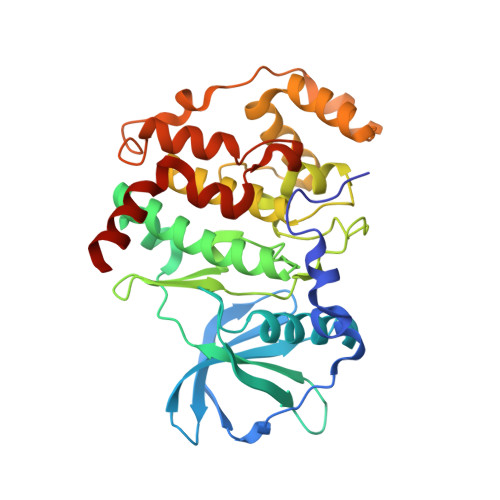Structural analysis of fungal pathogenicity-related casein kinase alpha subunit, Cka1, in the human fungal pathogen Cryptococcus neoformans.
Ong, B.X., Yoo, Y., Han, M.G., Park, J.B., Choi, M.K., Choi, Y., Shin, J.S., Bahn, Y.S., Cho, H.S.(2019) Sci Rep 9: 14398-14398
- PubMed: 31591414
- DOI: https://doi.org/10.1038/s41598-019-50678-z
- Primary Citation of Related Structures:
6K3L, 6KO6 - PubMed Abstract:
CK2¦Á is a constitutively active and highly conserved serine/threonine protein kinase that is involved in the regulation of key cellular metabolic pathways and associated with a variety of tumours and cancers. The most well-known CK2¦Á inhibitor is the human clinical trial candidate CX-4945, which has recently shown to exhibit not only anti-cancer, but also anti-fungal properties. This prompted us to work on the CK2¦Á orthologue, Cka1, from the pathogenic fungus Cryptococcus neoformans, which causes life-threatening systemic cryptococcosis and meningoencephalitis mainly in immunocompromised individuals. At present, treatment of cryptococcosis remains a challenge due to limited anti-cryptococcal therapeutic strategies. Hence, expanding therapeutic options for the treatment of the disease is highly clinically relevant. Herein, we report the structures of Cka1-AMPPNP-Mg 2+ (2.40??) and Cka1-CX-4945 (2.09??). Structural comparisons of Cka1-AMPPNP-Mg 2+ with other orthologues revealed the dynamic architecture of the N-lobe across species. This may explain for the difference in binding affinities and deviations in protein-inhibitor interactions between Cka1-CX-4945 and human CK2¦Á-CX-4945. Supporting it, in vitro kinase assay demonstrated that CX-4945 inhibited human CK2¦Á much more efficiently than Cka1. Our results provide structural insights into the design of more selective inhibitors against Cka1.
Organizational Affiliation:
Department of Systems Biology, College of Life Science and Biotechnology, Yonsei University, 50 Yonsei-ro, Seodaemun-gu, Seoul, 03722, Republic of Korea.



















